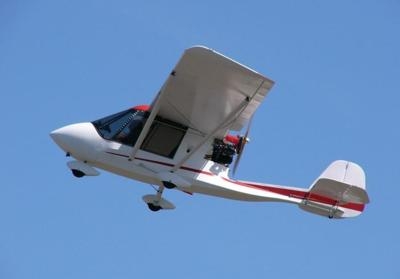Two People Fatally Injured In The Florida Accident
The NTSB has released a preliminary report from an accident which occurred in Crescent City, FL November 9.

The initial investigation finds that the airplane, an experimental amateur-built Challenger-II, N327SH, was destroyed during an in-flight breakup. The flight instructor and student pilot/owner were fatally injured. Visual meteorological conditions prevailed, and no flight plan was filed for the local instructional flight, which departed Skinners Wholesale Nursery Airport (16FD), Crescent City, Florida, about 0815. The airplane was privately owned and operated.
A witness stated that while outside in his front yard, he observed the airplane flying towards him on a southerly heading, above the trees on his neighbor's property. The engine noise decreased to what sounded like idle, and the airplane began to descend, "as if it were gliding." A few seconds later, the airplane pitched up sharply, and the engine noise became much louder, "as if it were trying to go up." He then heard a loud sound, and observed a wing separate from the fuselage. The fuselage then turned and went straight down into the woods below, which was about 1,000 feet north of the witness's location. The wing continued in the air briefly toward the south. The witness stopped looking for a moment and moved toward some shelter. When he looked up, the [right] wing was in his front yard next to his house, about 30 feet away from him.
Another witness who was located outside in the woods, about 500 feet east of the accident site, first observed the airplane flying overhead, "way above the trees," with the engine running. He then noticed that a parachute was trailing behind the airplane, uninflated, as it descended into the trees and impacted the ground. He said there was no explosion, no fire, and he did not see anything fall from the airplane.
According to a friend, the owner purchased the airplane about 3 weeks prior to the accident. He had flown with the flight instructor in the accident airplane at least twice. He considered flying to be a hobby; he had flown regularly with the flight instructor and received dual instruction; however, he did not intend to earn a pilot certificate.
The friend stated that about 1 week before the accident, the owner and the flight instructor experienced a "very hard" landing, after which, the main landing gear were "splayed out." A steel cable that ran between the landing gear under the fuselage, had broken. The owner had purchased a replacement cable and performed the repair himself 2 days prior to the accident.
The friend indicated that that the owner had previously been an airplane mechanic in the U.S. Navy.
The main wreckage came to rest in a wooded area in the vicinity of 29.408056 degrees north latitude, 81.514444 degrees west longitude. The majority of the airplane was severely fragmented with the major components found separated from the fuselage and damaged. Portions of the left wing came to rest in a tree about 30 feet high. The right wing was found largely intact about 1,000 feet south of the main wreckage. Wing fabric fragments and wing strut fairing fragments were strewn throughout a neighborhood south of the right wing location. The airframe parachute was found opened and with the main wreckage, the expended rocket motor and parachute sleeve were found in a tree about 600 feet southeast of the main wreckage.
The airplane was recovered to a salvage facility for further examination. All major components and flight control surfaces were identified. Flight control continuity could not be confirmed due to the extent of the impact damage. The two right wing struts (forward and aft) were fractured about mid-span, the ends of each remained attached to the fuselage and the right wing. The two right wing attach brackets, located on a centerline aluminum square beam at the top of the fuselage, were fractured and separated from the beam. A portion of the forward bracket was not found. The beam was fractured at the aft bracket location.
The two cylinder, two-stroke engine sustained impact damage and the two propeller blades were both fracture separated about 10 inches from the root. The engine was rotated by hand with some binding. An accessory pulley was damaged and impinging on the engine case. Both pistons moved as the engine was rotated, as observed through the intake manifolds. The two carburetors remained together as a unit with the air filter, separated from the engine. One carburetor's float bowl was separated and missing and the main jet housing was fractured with the jet missing. The other carburetor's bowl was removed; the floats were intact and the bowl was dry. A small amount of liquid consistent with the color of automobile gasoline was present in the inline fuel filter. One spark plug was fractured and could not be removed. The remaining three sparkplugs were removed; all electrodes were intact, and each exhibited tan and black coloration.
According to the airplane's maintenance records, the most recent condition inspection was performed on June 14, 2016, at which time the airplane had accrued a total of 124 flight hours. The airplane had flown about 18 hours since that inspection. Remnants from the right wing, its attachment fittings, a portion of the square centerline beam, and a recovered damaged circuit card from a handheld GPS unit, were forwarded to the NTSB laboratory, Washington, DC, for further examination.
(Source: NTSB. Public domain image from file. Not accident airplane)
 Airborne-Flight Training 05.09.24: ERAU at AIAA, LIFT Diamond Buy, Epic A&P
Airborne-Flight Training 05.09.24: ERAU at AIAA, LIFT Diamond Buy, Epic A&P ANN's Daily Aero-Term (05.07.24): Hazardous Weather Information
ANN's Daily Aero-Term (05.07.24): Hazardous Weather Information Aero-News: Quote of the Day (05.07.24)
Aero-News: Quote of the Day (05.07.24) NTSB Final Report: Cessna 150
NTSB Final Report: Cessna 150 Aero-News: Quote of the Day (05.08.24)
Aero-News: Quote of the Day (05.08.24)



